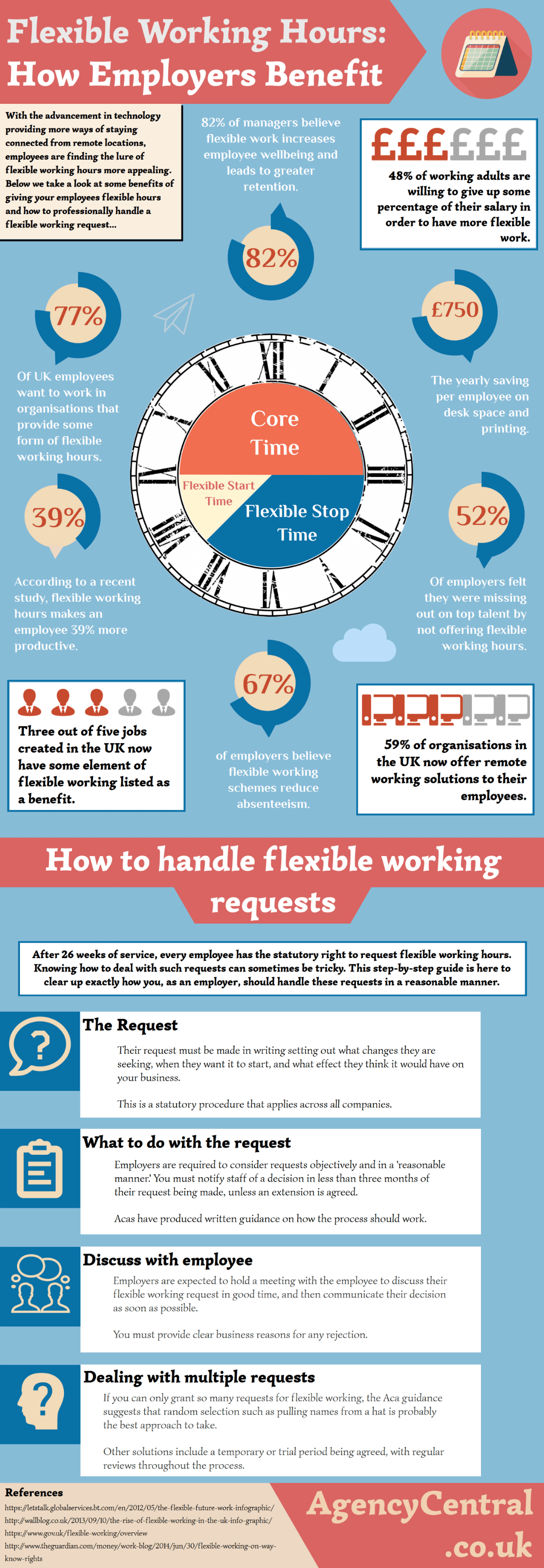As working practices begin to break down the cubicle walls and transcend the 9-to-5, flexible working is having a real impact on the way that employers manage their businesses. More than just moving the minute hand though, changing a long-standing working culture poses a number of challenges to employers, both from a legal and pragmatic perspective.
So what exactly is flexible working and what are the UK laws that employers need to know about?
What is flexible working?
Although an umbrella term that encompasses a broad spectrum of working conditions, ‘flexible working‘ involves any alteration of hours to suit the needs of an employee. This can range from working a shorter number of working hours, to squashing the same hours into fewer days. The concept brings into question when, where and for how long employees are obliged to work, affording staff the opportunity to manage their own time.
The right to request flexible working was initially introduced in 2003, however the law only extended to parents of young and / or disabled children. Employees who needed to care for relatives were also eligible to submit a request. In 2014 however, the limitations of who can apply were lifted and a much wider pool of people now qualify. This has brought to the fore a new set of considerations for employers, particularly on from a company procedure standpoint.
The different types of flexible working
Flexible working doesn’t involve just one way of doing things, and as an employer, there are numerous amendments to the standard working week that you could implement. From annualised hours to job sharing, each type of flexible working poses its own challenges and potential rewards.
Part-time:
Part-time work covers staff that work fewer hours than a full-time employee. Although there isn’t a legal guideline for how many weekly hours a part-time member of staff should complete, it’s generally considered to be fewer than 35. According to ONS, there were 8.3 million part-time workers in the UK during the period of September-November 2015. (only 15% of these couldn’t find full-time work).
Flexitime:
In order to help staff work around family commitments, you may decide to allow a certain level of flexibility over start and finish times. Flexitime is an idea that demands staff to be in the office for a core period of the day, but start and finish times are decided by the employee.

This usually involves employees making up a set amount of hours per day or week. For instance, if staff must work 7 hours a day, they may decide to start at 7:00 and leave at 14:00 or start at 10:00 and finish at 17:00.
Annualised hours:
Annualised hours sets a yearly target of hours that an employee must complete. This style of working is most often used in industries that experience predictable highs and lows. Once the number of annual hours is agreed, staff will complete these at a variable rate throughout the year, and may involve shift working.
Job share:
In some circumstances, it may make sense to share the responsibility of one job amongst two or more people. This is known as job-sharing and involves dividing hours between multiple staff, who will then carry out the same role. Staff that share a job are generally referred to as ‘partners’ and could work alternate weeks, days or any other combination of hours. Hours however, don’t need to be equal. It’s important to note that this is not the same as ‘job-splitting,’ where different aspects of a role or project are designated to different people depending on expertise.
Compressed hours:
If employees think that an extra day off would equate to a better personal-professional balance, then it could make sense to introduced compressed hours. This is where an employee will work the same number of weekly hours, but in a shorter amount of time. Instead of working 8 hours a day, 5 days a week, staff may work 10 hours a day, but for 4 days a week.
Zero-hours:
Zero-hours contracts enable employees to enter a contract with a business without any guarantee of actual work. Hours are distributed at the need / whim of the employer and this can range from a full working week to zero-hours. There is no obligation to provide work for zero-hour employees. Exclusivity clauses are occasionally used to prevent staff from accepting work elsewhere, however, new in 2016, staff can no longer be dismissed for this reason.
Work from home:
There are 4.2 million home-workers in the UK (as of Jan-Mar 2014) and this accounts for those that don’t spend their work-time in a normal working environment. This doesn’t necessarily mean that staff have to work exclusively from home, and they may decide to take their laptop to a coffee shop or co-working space. Home-working can be a full-time or part-time condition.
Why introduce flexible working?
If you’ve done any research into flexible working laws thus far, you’ll have seen that the terms ‘work-life balance,’ ‘staff morale,’ and ‘productivity’ appear prominently within the pro-arguments. Now while we don’t intend to analyse the impacts of flexible working too deeply, it pays to understand the impact that flexible working could have on your business.
While the aforementioned buzzwords may sound different, they ultimately all feed each other. What may seem like a small change to your employee’s work-life balance initially, can soon lead to a boost in staff morale, greater job satisfaction and a rise in productivity.
Now, it’s easy to see why a flexible working approach might lead to an improvement in job satisfaction amongst your staff. Removing the limitations of a conventionally structured working day could result in a positive response, as more freedom and implied trust undoubtedly go a long way. This, in turn, can result in greater feelings of a work-life balance.
A study conducted by the IBM Smarter Workforce Institute found that implementing just one method of flexible working can significantly increase positive feelings of work-life balance, something that might be worth noting if you’re still indecisive.
Naturally then, you would expect happy employees to be productive employees and there are certainly a number of studies that back this up.
Removing the limitations of a conventionally structured working day could result in a positive response, as more freedom and implied trust undoubtedly go a long way.
One such study was carried out by telecoms giant Vodafone, who surveyed 8,000 employers and employees from across the world. As well as reporting that 75% of companies have now implemented some form of flexible working approach, 83% of their respondents stated that flexible working has improved productivity.
Regus, a global workspace provider, carried out a similar study which garnered similar results. Their 2012 survey, which involved 16,000 of their own database contacts, showed that 72% of business were experiencing an increase in productivity as a ‘direct result of flexible working practises.’ 68% also reported that flexible working led to an increase in revenue.
So while you might think that flexible working is more of an employee bonus, the long-term benefits belong to the company. As well as boosting productivity (and therefore revenue), candidates will also view you more favourably and this opens up your scope for recruitment.

Who qualifies for flexible working hours?
Providing that your employees have been with the company for at least 26 weeks, the law states that almost everyone is entitled to request flexible working hours. This is known as a statutory application, however you can choose to extend this to office newbies.
Just because your staff have the right to apply for flexible working, this doesn’t mean that you’re obliged to accept any pleas, however you must have a sound reason for a rejection. If you do reject an application, that employee is unable to apply for flexible working for at least a year.
There are very few staff members that have no legal right to make a request, however agency staff, directors and anyone who isn’t considered an ’employee’ are included in this small bracket. Additionally, you may also have workers who have sacrificed some employment rights in exchange for shares in the business. These are known as having ‘employee shareholder status.’
The process
If staff want to request flexible working hours, they must submit a request to you in writing (or email). At this stage, although not statutory, it is good practice to have a meeting with the employee to discuss the details of the request. This might help you gain a better understanding as to why an employee may want to make a change to their working hours.
Once you have received the request, you are legally obliged to come to a decision within three months. This also includes appeals. If you accept the request, you should then amend the employee’s contract, however a rejection needs to be made to the employee in writing.
You can only reject an employee’s request for flexible working if you have sound reason. Although this may be appealed against, the cause for rejection must come from the following list (according to acas):
- The burden of additional costs.
- An inability to reorganise work amongst existing staff.
- An inability to recruit additional staffa detrimental impact on quality.
- A detrimental impact on performance.
- Detrimental effect on ability to meet customer demand.
- Insufficient work for the periods the employee proposes to work.
- A planned structural change to the business.
Each application is required to be considered in a ‘reasonable manner,’ and this list minimises the risk of personal feelings becoming a factor.
Appeals
Although there is no legal right for employees to appeal a rejection, it’s wise to offer an appeals process. If nothing else, this will prove that you’re able to stand by your decisions. Any appeal must be carried out according to workplace dispute procedures.
Just because your staff have the right to apply for flexible working, this doesn’t mean that you’re obliged to accept any pleas, however you must have a sound reason for a rejection.
Staff can make a complaint to an employment tribunal if they think you mishandled their flexible working request. This includes not dealing with the matter in a reasonable manner and dismissing staff as a result of a request. COMPLAINTS CAN’T BE MADE PURELY BECAUSE THE REQUEST WAS REJECTED.
Any complaint must be made within 3 months of receiving your decision or when the decision was due.
Advice for employers in dealing with flexible working
Although there is no fool-proof strategy to implementing a new culture of flexible working, there are few tips that employers might want to consider before going all in.
Consider every request fairly (but that doesn’t mean you have to say yes!)
Just because staff have a right to submit a request for flexible working, they have no actual right to flexible working. Despite this, you still have to consider each case fairly and can’t simply reject a request without justified reason. Instances where you say ‘no’ without being clear as to why, could be misconstrued as discrimination.
Think beyond Yes or No
While you might think that a request for flexible working ultimately comes down to a clear yes or no on your part, you might want to deem it more of a negotiation. Just because you’re not able to grant the precise request of an employee, doesn’t mean that you can’t suggest an alternative that benefits both parties. This will only help strengthen the relationship that you have with your staff.
Don’t hurt employee relations
Any issue like this has the potential to drive a wedge between employees and the powers that be. You should always aim to be as helpful and accommodating as possible when dealing with staff, especially when they’re approaching you with something. Failing to deal with requests appropriately could hurt morale within your business, as well as the trust that staff have in you.
Try to understand the employee POV
On paper, a request for a change in working hours can be difficult to understand if you’re an employer. If your business has only ever been familiar with the 9-to-5, then the thought of breaking that for just one employee can feel a little nonsensical. That’s why it’s best to sit down with the employee in question and discuss things face-to-face. You might start to see their point of view and agree that a change in working schedule would benefit both of you.
Trial period?
If you have any reservations about loosening the reins on your employees, consider a trial period. This experimental phase will enable you to witness first hand the potential pros and cons of introducing flexible working to your business. You could also use this time to try out different types of flexibility and see which one works best, without the commitment of permanent change.
So what have we learned?
Flexible working may or may not be right for your business, but if you’re thinking about implementing a new timetable for employees, it’s important to know the laws surrounding the issue.
Although workers now have a legal right to request a flexible working schedule that suits them, you’re under no obligation to be accommodating. Despite this, there’s still a process that needs to be adhered to and failing to do so can cause a relationship breakdown between yourself and your workforce. While it may only seem like a simple business issue, how you deal with employee matters such as this, can define a company culture and set a precedent for future situations.
Legal practices are there to protect the employee, as well as the employer, and knowing your way around flexible working laws will ensure that your business is capable of implementing a new and beneficial way of working.



